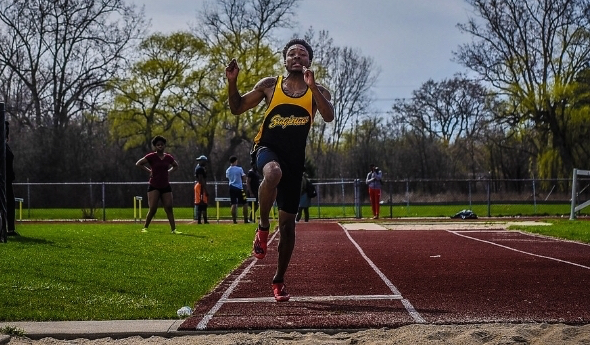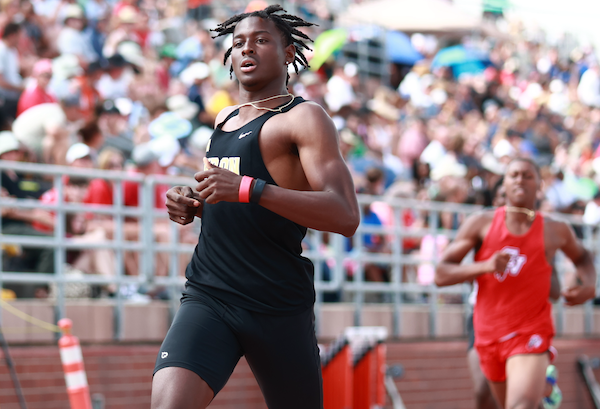
Saginaw's Martin Leaps Into All-Time Elite
By
Paul Costanzo
Special for MHSAA.com
May 1, 2019
Sometimes greatness can come from random circumstance.
 One spring day after having their basketball taken away during lunch, then-Saginaw High sophomore Tony Martin and his friends improvised by playing the game without a ball. With one of his track coaches looking on, Martin received a “pass” from a teammate, ran to the free-throw line and took off, touching the rim before returning to the ground.
One spring day after having their basketball taken away during lunch, then-Saginaw High sophomore Tony Martin and his friends improvised by playing the game without a ball. With one of his track coaches looking on, Martin received a “pass” from a teammate, ran to the free-throw line and took off, touching the rim before returning to the ground.
“You’re long jumping at our next meet,” the coach said, introducing a new event to the sprint specialist, and a star was born.
In the two years since that fake basketball game, Martin has become arguably the best long jumper in Michigan history. He recently leapt 26 feet, 6 inches, which according to michtrack.org smashed the previous record by a Michigan high schooler of 25-2½, set by Lansing Everett’s Marcel Richardson in 1988.
“I felt it when I hit the board, and when I was in the air, because I had more time in the air to move my legs and reach,” said Martin of his record-breaking jump, which he achieved April 25 in a home dual meet against Saginaw Arthur Hill. “I had more of a fold in my legs when I was landing. I felt it in my spine when I was stretching. My reaction was, I looked at it and it said 26-6, and I had to look again because it’s an unbelievable jump. I had to look at it again and again when they marked it.”
Martin, who opened his senior season at Saginaw by breaking the school’s 45-year-old long jump record, came into the year looking to set school and state records. As the calendar turns to May, he’s setting his sights farther.
“Right now, it would have to be me breaking the national record,” Martin said. “It has to be the national one now, because really there’s no other one. The only other thing I could think about is actually hitting the Olympic standard.”
The national high school record as regarded by the National Federation of State High School Associations (NFHS) is 26-4¾, jumped by Tulane Union, California’s James Stallworth in 1989. Others consider the national record to be 26-10, set in 2009 by current San Francisco 49ers wide receiver Marquise Goodwin while a high schooler at a USA Track & Field junior championships meet. The Olympic standard is 8.22 meters, which is a little more than 26-11½.
The MHSAA record book includes only Finals performances, and the MHSAA generally confirms records to the National Federation record committee that have occurred only during Finals, where officials are on hand to certify results and conditions including wind speed. (The MHSAA Finals record of 24-2¾ was set in 2017 at the Lower Peninsula Division 1 meet by Salem’s Mason Phillips.) However, an official will be on hand at Friday’s Bay City Western Invitational to monitor the long jump and certify the national record if Martin breaks it.
Martin’s 26-6 would tie for seventh all-time nationally, with only four people ever jumping farther at the high school level. Among them is United States Track & Field legend Carl Lewis, who had an official high school best of 26-8¼.
“I’ve watched him jump against Mike Powell every day,” Martin said of the epic 1991 showdown between Powell and Lewis at the 1991 World Championships, where Powell broke the world record. “That’s what I study, that video of Mike Powell breaking the record. That’s like my favorite track video ever (along with) videos of Usain Bolt. It’s definitely an honor joining somebody that I’ve watched.”
 Saginaw coach DeEddie Sanders believes Martin can reach those goals.
Saginaw coach DeEddie Sanders believes Martin can reach those goals.
“He’s got the potential, if he keeps working hard, to make the Olympic team,” Sanders said. “That’s what he wants, and I know he’s going to keep working hard.”
Martin, who has signed to compete for Michigan State University, came into this season plenty accomplished. He is the reigning Division 2 MHSAA Finals champion in the long jump, and a returning state placer in the 100 (fourth) and 200 (third) meters. He was also part of Saginaw’s fifth-place 400 relay team.
Last season’s Finals were a high point for his career, but also something he saw as just the beginning.
“It was pretty exciting,” Martin said. “It was emotional, because I was really tired at the state meet my sophomore year from jumping. I was not ready for the state meet at all (as a sophomore), so I had to win something (as a junior). That’s my goal (this year); I have to win all three for me to be satisfied, really. That is my goal, and I feel like I really have a chance this year.”
Martin has official personal bests of 10.71 seconds in the 100 and 21.71 in the 200, although he’s been hand-timed at 10.25 and 21.5. He said his goal is to get under 10.5 and 21 officially (fully automatic time), which would certainly put him in the running for a sprint double at this year’s Finals.
He should be a heavy favorite in the long jump, of course, and a lot of that can be attributed to taking a longer approach. After lining up about 80 feet from the pit in past years, Martin was urged to move backward to about 100 feet by the coaches he spoke with on his college visits. That allows him to build up more speed before takeoff.
“Ever since I changed my mark from indoor to outdoor, because I got faster, every time I jump is a (personal record), or over my best from last year,” Martin said.
In his first meet of the season, Martin showed that off, jumping 24-¼ to eclipse his previous best of 23-4¾, and the Saginaw High record of 23-7¾ set by Larry Foster in 1974.
“That was something that I cherished for a long time,” said Foster, who went on to play football and basketball at Northern Illinois, and now lives in Atlanta. “I’m glad I was alive to see him break it. I didn’t think it was going to last 45 years. I thought maybe in the 80s or 90s, somebody would break it. But my daughter, she was born in ‘74, and when she turned 45, I realized that was a long time. I’m so proud of that young guy. He did a fantastic job.”
Foster, who said he went to school with Martin’s grandmother, said he was able to speak with Martin and congratulate him after the record was broken.
“In a way, I was hoping it would (last) a little longer,” Foster said. “But 45 years, that’s long enough for me. When he goes to college, I’m going to follow him. I’m very proud of him.”
What Foster will be following is an athlete who believes he can further tap into his potential at MSU – a potential that even amazes Martin himself.
“To me, it’s unbelievable, because I’m only in high school and I’ve only been jumping since my sophomore year,” Martin said. “I’m kind of surprising myself every meet. It’s kind of unreal.”
 Paul Costanzo served as a sportswriter at The Port Huron Times Herald from 2006-15, including three years as lead sportswriter, and prior to that as sports editor at the Hillsdale Daily News from 2005-06. He can be reached at [email protected] with story ideas for Genesee, Lapeer, St. Clair, Sanilac, Huron, Tuscola, Saginaw, Bay, Arenac, Midland and Gladwin counties.
Paul Costanzo served as a sportswriter at The Port Huron Times Herald from 2006-15, including three years as lead sportswriter, and prior to that as sports editor at the Hillsdale Daily News from 2005-06. He can be reached at [email protected] with story ideas for Genesee, Lapeer, St. Clair, Sanilac, Huron, Tuscola, Saginaw, Bay, Arenac, Midland and Gladwin counties.
PHOTOS: (Top) Saginaw High sprinter and long jumper Tony Martin prepares to launch. (Middle) Martin is taking aim this spring at MHSAA Finals and national records. (Photos by Scott Keyes.)

St. Joseph Boys Make Every Point Count in Clinching 1st Finals Since 1997
By
Keith Dunlap
Special for MHSAA.com
June 3, 2023
ROCKFORD – Entering the final event of Saturday’s Lower Peninsula Division 1 Final, the 1,600 relay, St. Joseph was in first place – but by the slimmest of margins.
St. Joseph had 35.75 points, while Rockford had 35, Clinton Township Chippewa Valley had 32, and Ann Arbor Huron had 30.
Bears head coach Todd Rose knew his team was in the second heat before faster teams after, but his for sure needed to be faster than Rockford.
“I don’t teach them to worry about who they are running against,” Rose said. “Just run within themselves and run how we teach them.”
St. Joseph did that behind the team of Shay White, Will Fiesbeck, Eli Toney and Alex Moyer, finishing fourth in the event with a time of 3:21.50 to earn a meet-best 40.75 points – clinching the program’s first Finals team championship since 1997.
Chippewa Valley was runner-up with 38 points, while Rockford was third at 36 points.
St. Joseph senior Gerald Capaccio scored 18 precious points for his team, most notably winning the discus with a winning throw of 167-2. Capaccio said he was in second going into his last throw.
 “I just had the mindset that everyone can have a big throw, and it just has to be me that gets the big throw,” Capaccio said. “It happened on my final throw.”
“I just had the mindset that everyone can have a big throw, and it just has to be me that gets the big throw,” Capaccio said. “It happened on my final throw.”
Capaccio also was second in the shot put with a throw of 56-11¼.
In addition to Capaccio earning big points in the shot put and discus, Rose gave credit to high jumper Joshua Scott for finishing in a tie for seventh in that event. That gave the Bears two points, and they proved to be especially important as the team won by less than one.
It’s rare when a runner does something that hasn’t been achieved since before automobiles were invented, but Ann Arbor Huron senior Braxton Brann had that distinction.
Brann won the 110 hurdles and the 200 dash, becoming the first athlete to win those two events at the same state meet since 1895 – three decades before the MHSAA was formed.
“It’s great to be in that kind of conversation,” said Brann, who will run in college at Ohio State.
First, Brann won the 110 hurdles in a time of 13.77. He said that was the event he was most concerned about.
“I haven’t really been consistent, so I just wanted to be that,” Brann said.
Feeling much more comfortable and at home in the 200 dash, Brann ran a winning time of 21.12.
“Everybody comes in looking at the stats of everybody else,” he said. “I saw I was in the best position to win. But I knew I had to run by butt off against this great field and come out with a win.”
 Just about everyone in the stadium did a double-take when Northville’s 3,200 relay time was posted. The team of Brandon Latta, Brock Malaikal, David Whitaker and Brendan Herger set a new all-Finals record with a blistering time of 7:35.32, which was the best time in the nation this year.
Just about everyone in the stadium did a double-take when Northville’s 3,200 relay time was posted. The team of Brandon Latta, Brock Malaikal, David Whitaker and Brendan Herger set a new all-Finals record with a blistering time of 7:35.32, which was the best time in the nation this year.
Herger said when he got the baton on the anchor leg, he knew his teammates set him up incredibly well. But even he and Northville couldn’t have foreseen this.
“I had to run 1.54 to get it, and then I ended up running a bit faster than that,” Herger said. “I was so happy. I love my boys so much. It was great to share the moment together.
Herger also ended up finishing second in the 800 meters with a time of 1:52.19 behind Utica’s Trent McFarland.
Detroit U-D Jesuit senior Jaiden Reed won the 100 (10.74), and Clinton Township Chippewa Valley junior Shamar Heard won the 400 (47.78). Grand Rapids Ottawa Hills senior Benne Anderson won the 1,600 (4:05.44), and Grand Haven junior Seth Norder won the 3,200 (9:04.68). Kalamazoo Central senior Kayenn Mabin won the 300 hurdles (38.31). Rockford in the 400 (42.01), Chippewa Valley in the 800 (1:26.41) and Oak Park in the 1,600 (3:18.90) also won relay titles.
Battle Creek Lakeview senior Andrew Berryhill was champion in the shot put (58-¼), and Saline senior Dolan Gonzales won pole vault (16-0). Ann Arbor Huron junior Andrew Harding won the high jump (6-7), and Canton sophomore Quincy Isaac won the long jump (22-11). New Baltimore Anchor Bay sophomore Luke Bowman competed in the adaptive 100 (19.65), 200 (35.66) and 400 (1:14.39).
PHOTOS (Top) St. Joseph celebrates its LPD1 championship Saturday. (Middle) Ann Arbor Huron's Braxton Brann finishes one of his two race wins. (Below) Northville makes the final exchange of its record-setting 3,200 relay. (Photos by Jamie McNinch [top two photos] and Carter Sherline/RunMichigan.com.)

